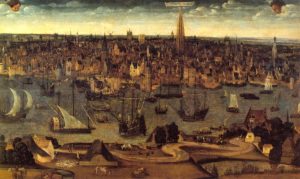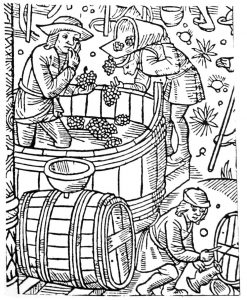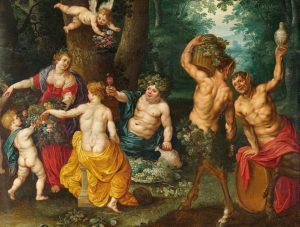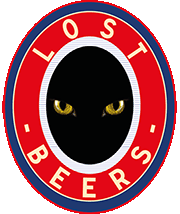A pub crawl through 16th century Antwerp
 There are many Belgian cities where you can go through the night, from pub to pub. Cafés like dark holes hidden behind small Medieval portals, or gritty workman’s cafés in harsh white light. But the best place for a pub crawl is Antwerp: a cocktail of sailors, students, elderly hippies, workmen and drunk Dutchmen. And in the 16th century this wasn’t much different, if we are to believe someone who should know: the deity Bacchus himself.
There are many Belgian cities where you can go through the night, from pub to pub. Cafés like dark holes hidden behind small Medieval portals, or gritty workman’s cafés in harsh white light. But the best place for a pub crawl is Antwerp: a cocktail of sailors, students, elderly hippies, workmen and drunk Dutchmen. And in the 16th century this wasn’t much different, if we are to believe someone who should know: the deity Bacchus himself.
Today, Antwerp has about 870 pubs.[1] To go and have a pint at each and every one of them would take you over a year, and would probably destroy your liver in the process. Most of them are of course in the city centre, this labyrinth of streets and alleys, here and there brutally separated by wide avenues. Who knows how often I’ve roamed around there, in the legendary Kulminator, gin bar De Vagant or the cheerful Den Engel… or that one time that a friend and me by accident ended up in a Flemish nationalist café (big yellow flags on the wall) and that in all our innocence we dared ask: ‘Gosh, Stella, is that Flemish?’
 Antwerp pub life is eternal, if the ‘Mandement van Bacchus’ is anything to go by, a satirical text from 1580 that gives us an insight into the drinking habits of those days.[2] An insight that is quite instructive to anyone who wants to know more about Belgian beer history. At that moment, Antwerp was the place to be: with its 100,000 inhabitants, it was the biggest city in the Low Countries. Amsterdam and Brussels both were no less than three times as small. Antwerp was at the top of its own Golden Age: it was the most important trading city in North-Western Europe, and the riches were piling up. Also, in 1577 the loathed Spanish had been kicked out, and the city had enjoyed freedom of religion since. Calvinism was now officially allowed. This did not prevent nightlife from thriving however…
Antwerp pub life is eternal, if the ‘Mandement van Bacchus’ is anything to go by, a satirical text from 1580 that gives us an insight into the drinking habits of those days.[2] An insight that is quite instructive to anyone who wants to know more about Belgian beer history. At that moment, Antwerp was the place to be: with its 100,000 inhabitants, it was the biggest city in the Low Countries. Amsterdam and Brussels both were no less than three times as small. Antwerp was at the top of its own Golden Age: it was the most important trading city in North-Western Europe, and the riches were piling up. Also, in 1577 the loathed Spanish had been kicked out, and the city had enjoyed freedom of religion since. Calvinism was now officially allowed. This did not prevent nightlife from thriving however…
 In 1580 an eight-page booklet called ‘Het mandement van Bacchus’ was published, which means ‘Bacchus’ indictment’. In fact, it was a parody of the language used in judicial subpoenas: in the text Bacchus, lord of wines and beers, summonses his subjects to appear in his courthouses, which are of course his pubs. The charge: drunkenness and staining fox skins, apparently used in pubs against the cold. 32 wines and 30 beers are summed up, in descending order of quality. Also, ‘Bacchus’ mentions 92 pubs, which is only a part of the at least 376 public venues the city knew at that moment. It’s not known who the actual author is, possibly he was one of the furriers mentioned in the text.
In 1580 an eight-page booklet called ‘Het mandement van Bacchus’ was published, which means ‘Bacchus’ indictment’. In fact, it was a parody of the language used in judicial subpoenas: in the text Bacchus, lord of wines and beers, summonses his subjects to appear in his courthouses, which are of course his pubs. The charge: drunkenness and staining fox skins, apparently used in pubs against the cold. 32 wines and 30 beers are summed up, in descending order of quality. Also, ‘Bacchus’ mentions 92 pubs, which is only a part of the at least 376 public venues the city knew at that moment. It’s not known who the actual author is, possibly he was one of the furriers mentioned in the text.
And which wines did the pubs of Antwerp serve? The first to be mentioned are the wines of the Rhine valley in Germany, in those days the most common quality wine in the Low Countries. After all, Germany wasn’t far away. After that, Bacchus sums up a few wines from the Mediterranean: Malveseyen (Malmsey), Romenyen, Muscadellen. These were sweet, liqueur-like wines from the Greek islands. Then follow a great number of French wines from regions like Gascony, Alsace, Anjou, Poitou and Burgundy. Except for the latter, these could easily reach a harbour city like Antwerp by ship.
 Interestingly, at the bottom of the list a few wines from Brabant are featured: those of Leuven, Aarschot and… Hoegaarden. Because yes, in Southern Brabant a few places now primarily known for their beers were once typical wine towns. By the 16th century, these were already on their way out. Their wines had never been much more than simple country wines, and they were appreciated less and less. High costs, a temporarily colder climate and warfare would eventually wipe these wines off the map for good. Only a few liqueur-like wines, those from Roeselberg hill and ‘Tsertogen wijn’ (‘The duke’s wine’) from Leuven, were to Bacchus’ liking. However, these too would soon be extinct forever.
Interestingly, at the bottom of the list a few wines from Brabant are featured: those of Leuven, Aarschot and… Hoegaarden. Because yes, in Southern Brabant a few places now primarily known for their beers were once typical wine towns. By the 16th century, these were already on their way out. Their wines had never been much more than simple country wines, and they were appreciated less and less. High costs, a temporarily colder climate and warfare would eventually wipe these wines off the map for good. Only a few liqueur-like wines, those from Roeselberg hill and ‘Tsertogen wijn’ (‘The duke’s wine’) from Leuven, were to Bacchus’ liking. However, these too would soon be extinct forever.
Local beer was doing much better. Bacchus starts his beer list with a few foreign varieties: the thick Jopen beer from Danzig, Eastern beer from Hamburg, English beer and mom from Brunswick. However, these are followed by the beers from Hoegaarden and Leuven, two places that also featured in the list of wines. Their beers, at the time apparently the best to be found in what is now Belgium, were appreciated a lot better than their wines! These were strong beers, just like the beers from Zoutleeuw, or the Knol and double beers from Antwerp itself. Also ‘Goutse cuyte’ is mentioned, one of the last times the kuit beer from Gouda is found as a popular beer in the Southern Netherlands. Also the mention of beer from the French city of Rouen is interesting.
Our ‘Bacchus’ goes on to enumerate the beers from the villages around Antwerp: from Wilrijk, Deurne, Berchem, Ekeren, Merksem… This is very probably because there beer, free from city taxes, was a lot cheaper and therefore the people of Antwerp loved to go out of the city to have a cheap beer in the countryside. At the bottom of the list are small and ‘sharp’ beer, weak brews for the poor. Bacchus distances himself from them: he doesn’t want to have anything to do with such inferior beers.
 Then, there are the 92 pubs mentioned by Bacchus. Paul Verhuyck and Corine Kisling, who studied and annotated the text thoroughly in 1987, have done a brave attempt at identifying them all, with mixed results. Some pubs could not be found in the archives, while of others, like Den Engel (‘The Angel’), there were several. A few were in blocks that by now have been wiped off the map centuries ago during several phases of urban renewal.
Then, there are the 92 pubs mentioned by Bacchus. Paul Verhuyck and Corine Kisling, who studied and annotated the text thoroughly in 1987, have done a brave attempt at identifying them all, with mixed results. Some pubs could not be found in the archives, while of others, like Den Engel (‘The Angel’), there were several. A few were in blocks that by now have been wiped off the map centuries ago during several phases of urban renewal.
In any case, the thirsty drinkers of Antwerp could go to venues like ‘Die Leeuwe in ‘t Appelstrate’ (‘The Lion in Apple Street’), ‘in ‘t Wielken’ (‘The Wheel’), ”t Geschildert Huys’ (‘The Painted House’) or ”t Gulde Peert’ (The Golden Horse’). One place is notably absent in the text: the Gulden Boom (‘Golden Tree’) inn, in which, according to a well-known early 16th century tale, the devil, calling himself Moenen, stayed with the innocent girl Mariken van Nimwegen, to live in sin. The pub crawl ends ‘In front of the church door of the great hospital’, which means drunk, poor, destitute and ill. A warning still relevant today…
It all seems so far away, and at the same time it seems like nothing has changed. The inns of those days have been replaced by today’s cafés. In 1585, five years after Bacchus’ Mandement, Antwerp was conquered by the Spanish, after which the city’s population halved. Antwerp was to face centuries of decay. But today, nightlife still thrives there, from hip mojito bar to sailor’s pub, and during the late hours, you just may cross the devil Moenen there.
Wines, beers and pubs in the Mandement van Bacchus (1580)
|
Wines |
Beers |
Pubs |
[1] https://www.nieuwsblad.be/cnt/dmf20150602_01711718
[2] Paul Verhuyck and Corine Kisling, Het Mandement van Bacchus, Antwerpse kroegentocht in 1580, Antwerp 1987.






Leave a Reply